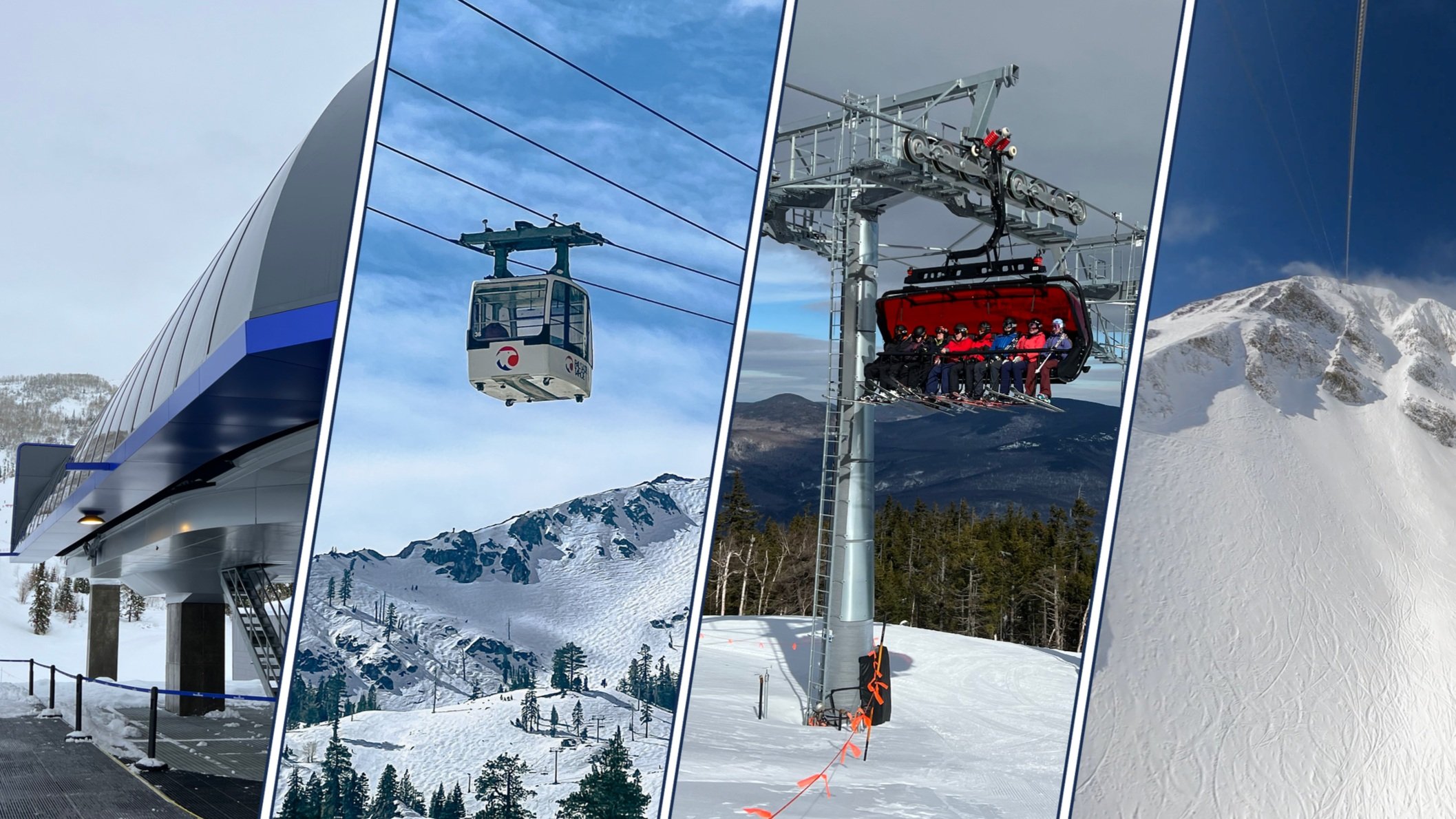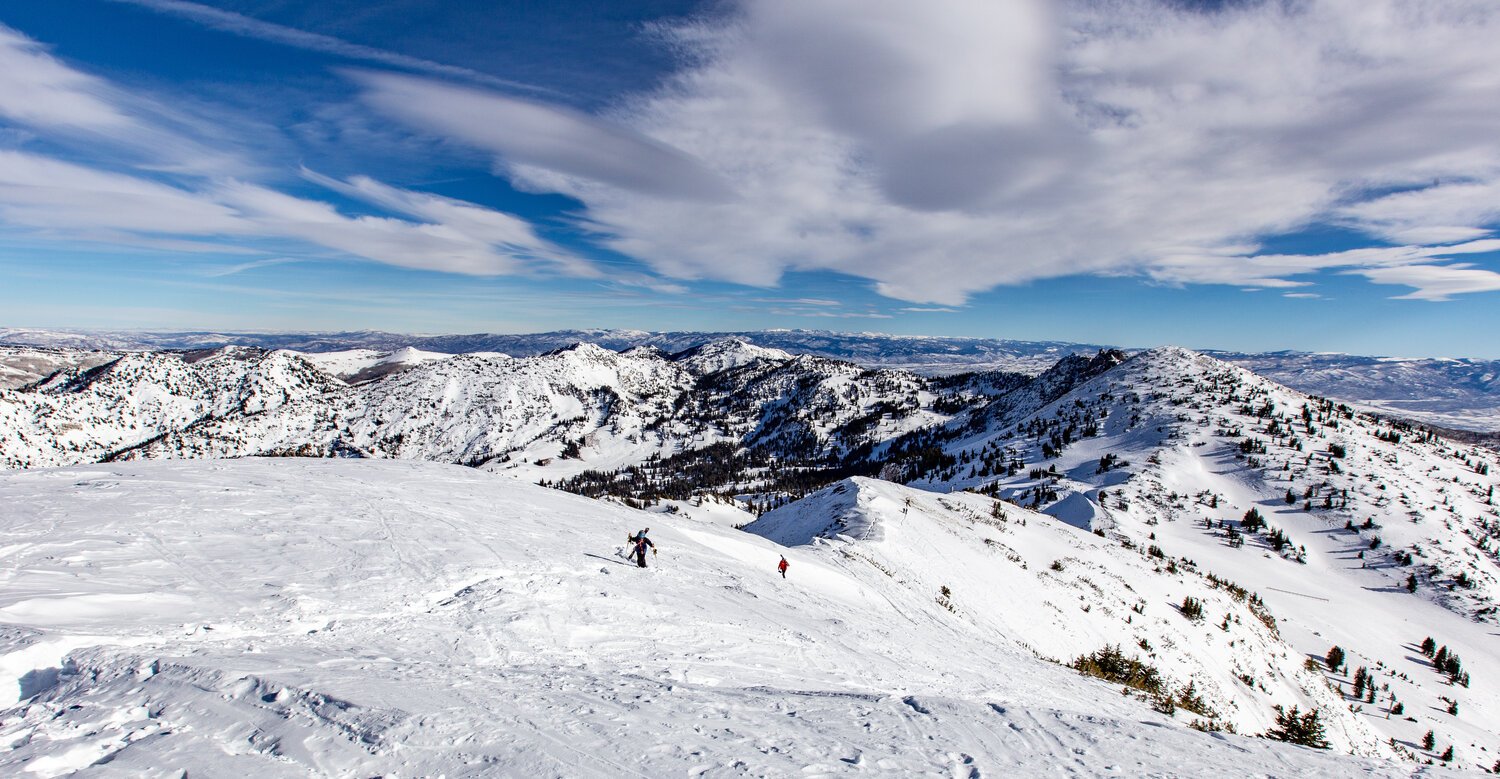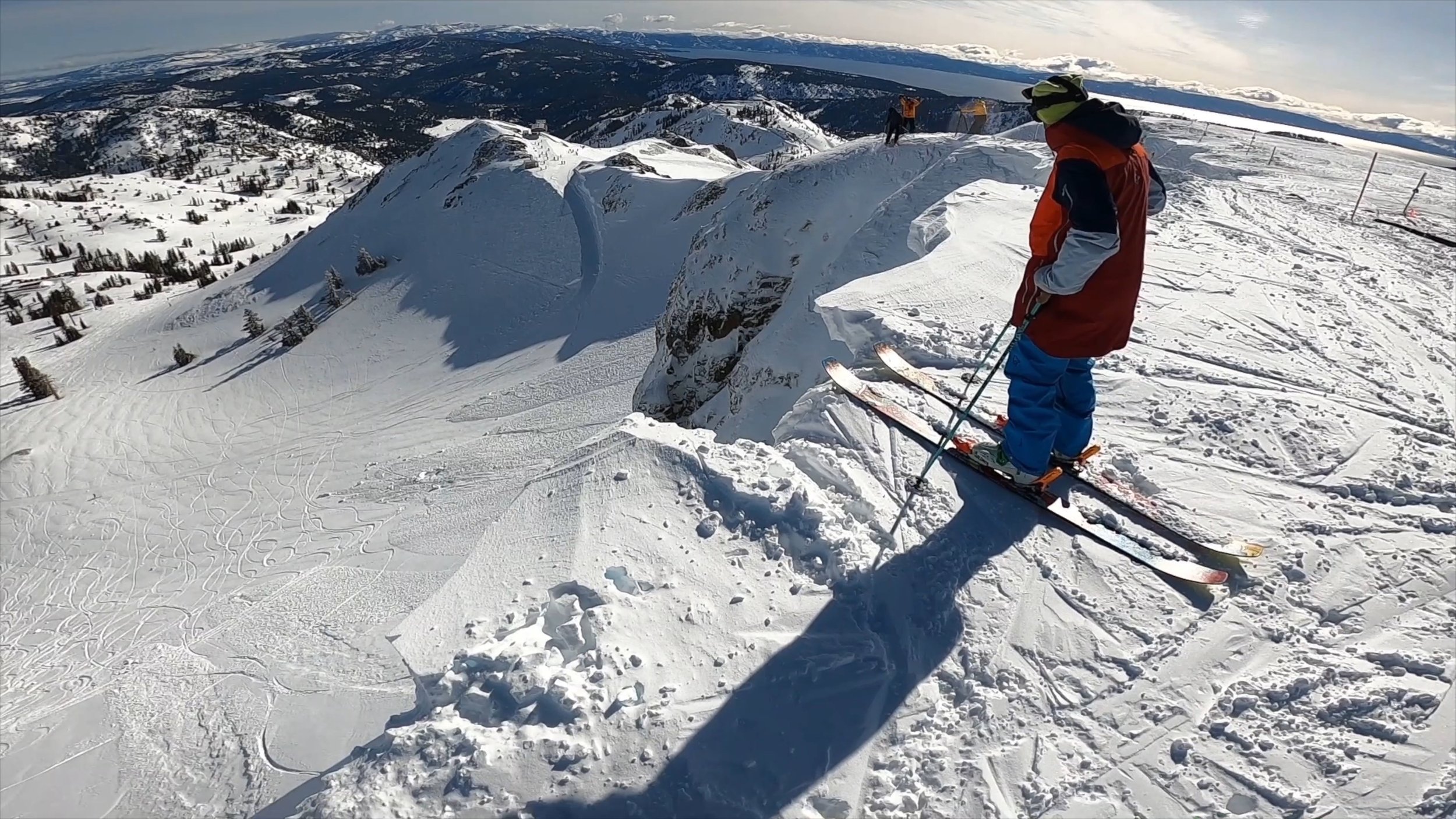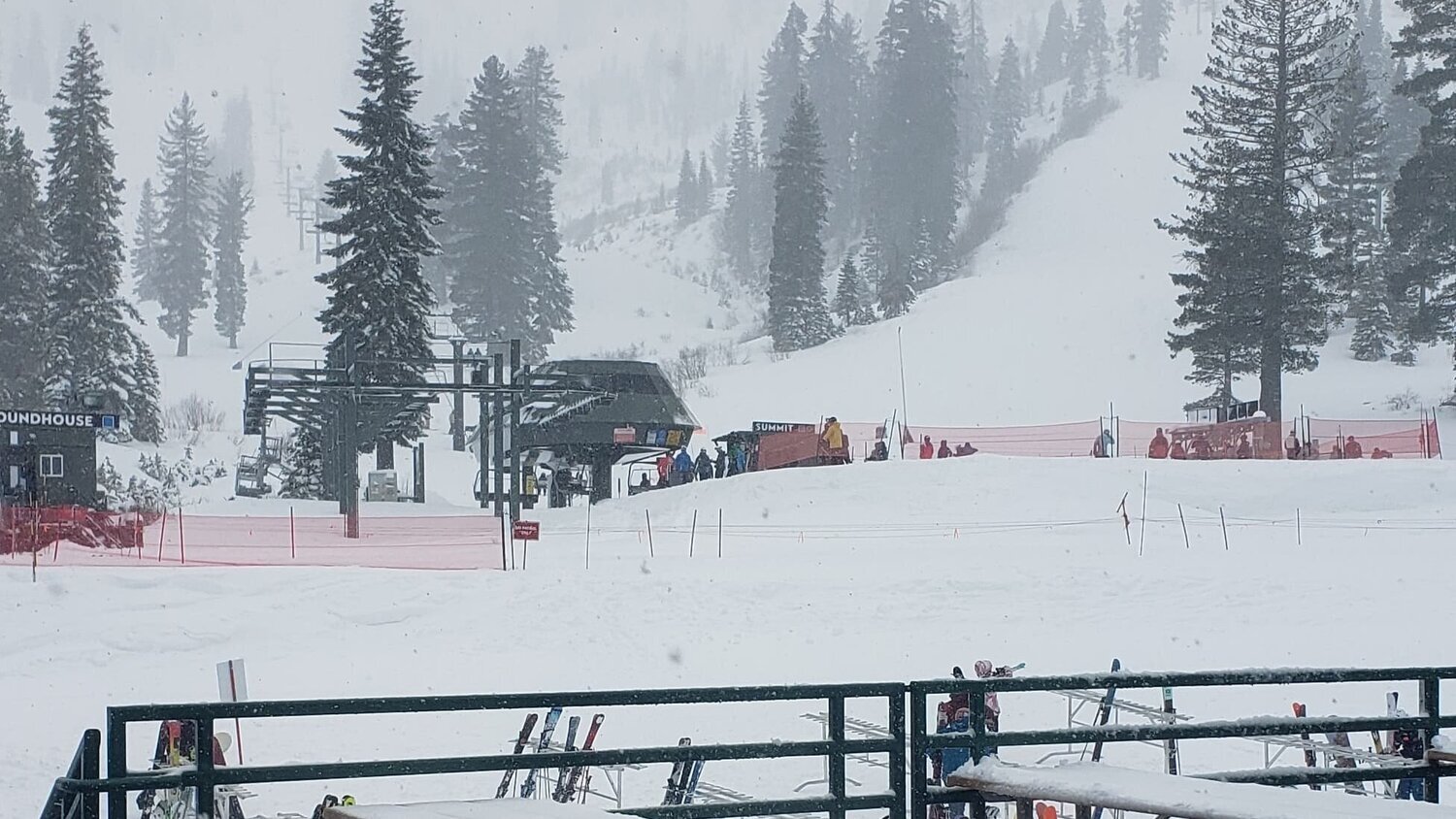MOUNTAIN SCORE
CATEGORY BREAKDOWN
See our criteria7
Snow:
5
Resiliency:
9
Size:
8
Terrain Diversity:
10
Challenge:
7
Lifts:
5
Crowd Flow:
6
Facilities:
6
Navigation:
9
Mountain Aesthetic:
GOOD TO KNOW
1-Day Ticket: $194-$279
Pass Affiliation: Ikon Pass
On-site Lodging: Yes
Aprés-ski: Extensive
Nearest Cities: Reno (1 hr), San Francisco (3.5 hrs)
Recommended Ability Level:
+ Pros
Wide variety of demanding expert terrain
Unique topography
Lively base village
Top-notch spring skiing experience
Large overall footprint
– Cons
Wind exposure, especially on beginner and low-intermediate terrain
Serious congestion issues in some areas
Variable openings for lower-elevation expert terrain
Impractical lift link between Palisades and Alpine sides
Considerable access road traffic on weekends and holidays
MOUNTAIN STATS
Lifts: 42
Trails: 270
Beginner: 6%
Intermediate: 32%
Advanced/Expert: 62%
RECENT ARTICLES
VIDEO
Mountain Review
Palisades Tahoe has long been a go-to for many in the Lake Tahoe area—but you wouldn’t know it by the name. The resort actually co-existed as two separate mountains, formerly known as Squaw Valley and Alpine Meadows, before receiving a new name and a gondola connection between the two resort sides. But is the newly rebranded ski resort, now the largest in California, a world-class force to be reckoned with—or were the two resort sides better off separate?
The merging of the already sizable Squaw Valley and Alpine Meadows ski resorts into Palisades Tahoe has resulted in a ski area that dwarfs all its Tahoe competitors.
Size
On the surface, Palisades Tahoe stands out for its size. At 4,030 skiable acres, Palisades Tahoe dwarfs all of its Tahoe competitors and offers a footprint only matched or exceeded by the largest mountains in North America. The Palisades footprint offers more than enough terrain to keep the right guests busy for a proper weeklong trip, and the unique topography across the resort makes for terrain pods that feel distinct from one another.
TRAIL MAP
Resort Sides and Base-to-Base Gondola
However, Palisades Tahoe is still really two separate resorts that are connected by a base-to-base gondola. Both the Olympic Valley side (more commonly known simply as the “Palisades side”) and the Alpine Meadows side are sizable on their own, essentially comprising a 60/40 terrain split (67/33 if excluding hike-to terrain) between the former and latter. The gondola linking them is very long, involving a sizable 15+ minute time investment to ride. And that’s assuming conditions are good—the base-to-base gondola can face delays, slow run speeds, or wind holds due to adverse weather conditions. Advanced and expert guests coming from the Alpine side can ski down part of the way to get to Palisades, but going the other way, there’s no terrain directly served by the base-to-base lift. As a result, alternating between the two resort sides isn’t exactly a hassle-free experience.
Thankfully, the two resort sides offer experiences that complement each other well. The Palisades side is bigger, more built-up, and home to more “in your face” terrain, while the Alpine side is more laid back, home to more hidden terrain gems, and—even with the new gondola connection—typically less crowded. The Palisades side also hosts the resort’s only public on-site lodging; the Alpine side lacks overnight accommodations.
Palisades Tahoe’s high-alpine beginner terrain makes for a enjoyable learning experience under the right circumstances, but it is uniquely exposed to high winds and harsh weather.
Beginner Terrain
Palisades Tahoe is not an ideal resort for beginners, although for less-experienced guests who visit, the Palisades side is the better choice.
The Alpine Meadows side’s beginner experience is a complete afterthought, with just two green trails on the entire resort side, and both of them being what’s essentially a bunny hill. There are some easier blue trails that could reasonably pass for greens, but they’re hard to distinguish. The Palisades side actually boasts some pretty solid green terrain under the right circumstances, with a high-alpine learning zone directly served by four lifts and one carpet, including one high-speed six-pack. However, this zone is very exposed and susceptible to harsh weather, making the conditions less than ideal for beginners when windy or stormy conditions arise. In addition, there’s no green route to get back to the base, meaning those who aren’t comfortable with more difficult terrain will need to download a lift to leave the resort. This also means that beginners cannot directly ski to Palisades’ First Venture bunny hill zone, which is located at the base, from the high-alpine green terrain.
Alpine Meadows may be the preferred area for intermediate skiers, with plenty of long cruisers with good views of Lake Tahoe.
Intermediate Terrain
On the other hand, the Alpine Meadows side is arguably better for guests of intermediate proficiency, especially low-intermediates. The vast majority of Alpine-side terrain zones offer multiple enjoyable blue cruisers, leaving plenty of options for intermediates to explore. Some of these runs are easier than typical blues—while others are harder—but after a bit of exploring, it’s pretty easy to find one’s way around. The Palisades side does have some decent intermediate areas, most notably the upper-mountain Gold Coast and Shirley Lake pods. However, many terrain zones within this part of the resort lack blue terrain entirely. And when it comes to leaving the resort from any upper-mountain area, guests who don’t want to download the Funitel will need to take the perennially congested Mountain Run trail, which often gets so crowded it’s more dangerous than fun.
Terrain Parks
That said, both resort sides offer decent, although not class-leading, terrain park setups. The Gold Coast and High Camp areas contain the overwhelming majority of the Palisades side’s terrain park areas; freestylers will find a range of small to large features, including boxes, rails, jumps, as well as the occasional mini pipe contingent on seasonal snow quality. On the Alpine side, visitors can find a handful of small and medium-sized features in lower- and mid-mountain areas.
Palisades Tahoe offers steep, challenging runs in most mountain areas at both sides of the resort.
Advanced Terrain
Where Palisades Tahoe starts to really stand out is in its advanced-level terrain. The resort offers steep, challenging runs across essentially every mountain area, with demanding mogul runs, tough-pitched bowls, and tight glades, depending on where one looks. Neither the Palisades nor Alpine sides set world records when it comes to pitch length, but the Palisades side generally sustains its steep pitches for longer spans than the Alpine side. Guests looking for a serious challenge should make sure not to miss the KT-22, Headwall, and Granite Chief zones on the Palisades side, as well as the Summit and Scott zones on the Alpine side.
RECOMMENDED SKIS FOR PALISADES TAHOE
NOTE: We may receive a small affiliate commission if you click on the below links. All products listed below are unisex.
Recommended intermediate ski
Recommended advanced ski
Recommended high-alpine ski
Recommended powder ski
Expert and Extreme Terrain
For the 2022-23 season, Palisades Tahoe finally introduced a double-black-diamond rating for its hardest terrain. While these runs are all expert-level in difficulty, they range significantly in technicality, with some runs boasting typical expert pitches, and others involving some of the most dangerous in-bounds terrain in North America. Both the Palisades and Alpine sides involve trails that require mandatory straightlining or cliff drops in order to get down—and many of these runs can be accessed without any hiking required.
Hike-To and Traverse-Accessed Terrain
That said, a notable portion of Palisades Tahoe’s advanced and expert terrain requires hiking to reach. These lines take a bit of effort to get to, but none of the hikes take more than 15-or-so minutes and often host untouched powder longer than other resort areas. Many areas at Alpine Meadows are lift-served, but require significant traversing to reach; these areas can also take quite a while to reach, but also preserve snow well.
Palisades Tahoe hosts some of the most dangerous terrain in North America, with a multitude of extreme pitches, mandatory straightlines, and large cliffs spread across both sides of the resort.
Snow Quality
Speaking of snow, Palisades Tahoe typically receives the commendable accumulation one might expect from Lake Tahoe. During good seasons, the resort can see monumental snow totals, sometimes seeing feet of fresh powder in a 24-hour period. In addition, snow quality on the Alpine side stands out from local competitors thanks to fewer crowds and less tracked terrain.
However, Palisades’ snow quality is often heavier than that of destinations further inland in Colorado and Utah, and the resort can see freeze-thaw cycles, meaning that conditions may deteriorate only a day or two after a good storm. In addition, during bad seasons, Palisades can go weeks without a single snow event; this can result in icy conditions for days at a time. These factors make Palisades Tahoe a less reliable choice for an in-advance ski vacation than the destinations in the Rockies.
Palisades Tahoe typically receives commendable snow totals, but it still may not be a reliable choice for an in-advance vacation due to heavy snow quality, regular freeze-thaw cycles, and common snow droughts.
Resiliency
That said, snow cover typically stays consistent, and the resort employs extensive snowmaking operations to ensure a reliable core season operating footprint. In addition, avalanche patrol operations have greatly improved in recent years, with lifts opening on time most mornings and once-common delays diminishing.
Palisades Tahoe is subject to a few other factors that impact mountain operations. Many parts of the resort face considerable wind exposure, and several upper-mountain areas see uncomfortable gusts throughout the season. Wind makes certain trails heavily susceptible to icy conditions, and some higher-elevation lifts can see wind holds.
Variable weather tends to affect the resort’s most extreme offerings the most. If you’re buying your tickets far in advance, don’t bet on being able to hit the formidable Silverado and Broken Arrow areas. These slopes, which offer some of the resort’s most extreme lower-elevation runs, need significant snowfall to open up—in especially poor seasons, this terrain doesn’t open at all.
Variable weather, high wind exposure, and a low base altitude can result in frequent closures of some of Palisades Tahoe’s most extreme terrain.
Ease of Navigation
As one combined resort, Palisades Tahoe is a bit more complex to navigate than it used to be; however, it still isn’t the worst offender out there. While the Palisades side is bigger, it’s generally more direct and intuitive to get between mountain areas, although some lifts, including the Base-to-Base Gondola itself, take a less-than-ideal amount of cat walking to reach. The Alpine side’s spread-out, traverse-laden footprint preserves terrain but can make access less straightforward. Signage is generally straightforward on both sides, but cutoffs to certain lifts and resort areas aren’t as clear as they should be due to inadequate signage in some places.
Crowd Flow
Palisades Tahoe is one of the most popular ski resorts in the Lake Tahoe region, and as a result, the resort sees considerable crowding on weekends and holidays. Lines at the main Palisades-side lifts, including the Funitel, KT-22, and Gold Coast, often reach over 30 minutes long during peak times. The Alpine side doesn’t typically get as bad—even with the new gondola connection—but guests can expect 20-minute waits for the Summit and Treeline Cirque lifts during peak times.
Where the waits get really bad are on the access roads. If you’re coming from Truckee on a weekend, you could be waiting in an hours-long traffic jam to park at the resort and even get out of your car. These crawl-speed traffic conditions are pretty much a given on every core-season Saturday or Sunday with decent snow conditions.
High speed lifts, including the newly-replaced Red Dog lift, serve most key resort areas at Palisades Tahoe.
Lifts
But at least once you’re out of the lines, Palisades Tahoe boasts a modern lift setup. Most key resort areas enjoy high-speed lift service, and the Gold Coast Funitel, which provides the main link from the Palisades base to mid-mountain, features a unique dual-cable support system that gives it extra wind stability. The resort has replaced a number of slow, fixed-grip chairs with high-speed lifts in recent years, including the Red Dog chair on the Palisades side and the Treeline Cirque chair on the Alpine side.
On-Mountain Facilities
Thanks to its California location, Palisades Tahoe often sees milder winter temperatures than other popular ski regions. But even when weather conditions become uncomfortable, the resort features a number of lodges to stop in for a break. The Palisades side boasts two large, multi-level mid-mountain lodges with a number of dining options, while the Alpine side only has one true out-of-base facility but has a very large base lodge with plenty of room. The Palisades side’s expansive main base area offers an array of facilities with plenty of seating even during peak times, while the satellite Resort base also offers public dining and bathroom facilities.
RECOMMENDED SNOWBOARDS FOR PALISADES TAHOE
NOTE: We may receive a small affiliate commission if you click on the below links. All products listed below are unisex.
Recommended intermediate board
Recommended advanced board
Recommended high-alpine board
Recommended powder board
Getting There
Palisades Tahoe is a few miles west of Lake Tahoe, and the resort sits about three-and-a-half hours from the San Francisco Bay Area with no serious traffic. Palisades is also about an hour away from Reno, Nevada. Those flying to the resort will find the Reno airport the most convenient option, but the San Francisco airport often offers cheaper, more direct flights. Interstate 80 is the most direct route to reach Palisades Tahoe from either city, and the resort is about 10 miles from the highway.
Parking and Reservations
Parking exists at a reasonable walking distance from the lifts on both resort sides; however, the main lots fill up faster on the Alpine side. Overflow parking at Alpine is really inconvenient, requiring a modestly-long shuttle ride, but reasonably accessible parking on the Palisades side often stays open well into the morning.
For the 2023-24 season, Palisades Tahoe has introduced a new parking reservation system for all lots, including overflow areas, on weekends and holidays. Some of these reservations are free, meaning you don’t necessarily have to pay to drive to the resort. This parking reservation system stays in effect through 12pm on the days it’s active, after which visitors can freely park around the resort.
The resort does adjust the number of free parking spaces available, and these spots often fill up quickly. Each Tuesday, Palisades Tahoe releases the free spot reservations for the following weekend in two batches—one at 12pm PT, and one at 7pm PT. On the highest demand days, the free spots can fill up within minutes. If the following week includes a holiday period, the parking reservation system can get a bit wonky—the Tuesday batch release will include options to make reservations for those holiday dates as well—and may also include the option to book parking reservations for the following weekend.
If you do miss out on the free parking reservations, you may be able to pay to park, although these premium spots can sell out as well. In a worst case scenario, you can park in a lot in Truckee or Tahoe City and take a public bus to the resort.
Palisades Tahoe introduced a parking reservation system for the 2023-24 season, so guests visiting on weekends or holidays will have to plan ahead.
Access Road Traffic
Although the parking reservations have helped somewhat, the Palisades Tahoe access road is still home to serious traffic backups on peak weekends and holidays. This can turn the ten-mile journey from Interstate 80 to the resort into a prolonged, hour-long affair. On the other hand, off-peak weekdays are much better in this regard and rarely see traffic.
Lodging
When it comes to on-site lodging, all of Palisades Tahoe’s choices are on the Palisades side. Most of these accommodations are within the main base village; some of these are effectively ski-in/ski-out while others exist a short walk from the lifts. These offerings tend to be upscale and feature pools and hot tubs. The only other slopeside lodging option is the upscale Everline Resort & Spa, previously known as the Resort at Squaw Creek, which is located at a satellite base area. One can find reasonable prices at some of these places if the trip is booked far enough in advance, but calling them cheap would be a stretch.
The best budget options exist a few miles away in nearby Truckee and Tahoe City, although the Red Light Hostel, which used to be the cheapest accommodation in the North Lake area, has been temporarily closed to house seasonal workers. Those staying offsite will want to leave very early—say 6am or earlier—to avoid serious traffic jams on weekends and holidays.
Aprés-Ski
Thanks to its extensive base village, the overwhelming majority of aprés-ski activities occur on the Palisades side of the resort. This village is home to excellent happy hour deals across multiple bars, including the expansive outdoor KT Base Bar. Loudspeaker music and live bands are common occurrences. While on the slopes, guests can grab a drink at any of the mid-mountain lodges—as well as the outdoor Ice Bar when open on the Alpine back side—and soak in the striking views. There aren’t really any night clubs at Palisades, but a few bars in the town of Truckee offer nightlife once things in the base village start to quiet down.
For many guests, Palisades Tahoe will compare favorably to other resorts in the Tahoe region.
Verdict
Palisades Tahoe remains a striking resort with world-class terrain for experts, and thanks to the Base-to-Base Gondola, it now offers one of the biggest lift-connected footprints of any ski resort in North America. But the resort still functions as two separate mountains in many ways, and inconsistent conditions, limited beginner and low-intermediate terrain, and complications with parking and traffic mean the resort won’t be for everyone. Still, those in the Tahoe region will find it really hard to match the overall experience that Palisades Tahoe offers.
Pricing
However, access to what’s now California’s biggest ski resort does not come cheap. Lift tickets are now among the most expensive in North America, now starting at well over $200, even on off-peak dates. This astounding cost of entry is not seriously worth entertaining, and anyone thinking of visiting should really use an Ikon Pass or Tahoe Super Pack product for access to the resort. However, for the 2023-24 season, these commodities are unfortunately already off sale.






























If you plan on visiting certain resorts on the Ikon or Mountain Collective Passes, now is your last time to secure access at a remotely reasonable rate.